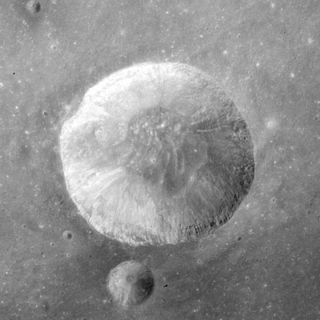
Cauchy is a small lunar impact crater on the eastern Mare Tranquillitatis. It was named after French mathematician Augustin-Louis Cauchy. It is circular and symmetric, with a small interior floor at the midpoint of the sloping inner walls. Due to the high albedo of this bowl-shaped formation, it is particularly prominent at full Moon.

Artamonov is a lunar impact crater on the far side of the Moon. Its eroded outer rim does not have the circular shape of most lunar craters, but the overall shape of three or four merged craters. The largest is in the south, with smaller circular bulges to the north and east.

Fabry is a large lunar impact crater of the form termed a walled plain. It is located on the far side of the Moon, just beyond the northeastern limb. Parts of this area are sometimes brought into view by the effects of libration, but the terrain is seen from the edge and so not much in the way of detail can be observed.

de Gerlache is a lunar impact crater that is located along the southern limb of the Moon, within a crater diameter of Shackleton at the south pole. From the Earth this crater is seen from the edge, and it lies in perpetual darkness. Thus little or no detail can be seen of this crater, other than the edge of the rim. However, the crater is clearly visible in Earth-based radar images. The crater is roughly circular, with some slight wear. No craters of note overlie the rim, although some formations may be attached to the southern and western edges.

Carmichael is a lunar impact crater that is located along the eastern edge of the Sinus Amoris, in the northeastern quadrant of the Moon's near side. Its diameter is 20 km. It was named after American psychologist Leonard Carmichael. It lies within a couple of crater diameters south-southwest of the smaller crater Hill. Further to the east-northeast is the prominent crater Macrobius. Carmichael was designated Macrobius A before being given its current name by the IAU.

Matisse is an impact crater on the southern hemisphere of Mercury. Matisse takes its name from the French artist Henri Matisse, and it was named by the IAU in 1976.

Mozart is a crater on Mercury, named by the IAU in 1976 after Austrian composer Wolfgang Amadeus Mozart.

Raphael is a crater on Mercury. Its name was adopted by the International Astronomical Union (IAU) in 1976, and is named for the Italian painter Raphael.

Hovnatanian is a crater on Mercury. Its “butterfly” pattern of ejecta rays were created by an impact at an even lower angle than that which formed neighboring Qi Baishi crater. From the "butterfly" pattern of rays, the Hovnatanian impactor was travelling either north-to-south or south-to-north prior to hitting Mercury's surface. Hovnatanian lies to the west of Tir Planitia.

Izquierdo is a crater on Mercury. Its name was adopted by the International Astronomical Union (IAU) in 2009, for the Mexican painter María Izquierdo. The floor of Izquierdo is smooth, the result of having been partially filled with volcanic lava. Circular outlines of the rims of “ghost craters” – smaller, older craters that have been largely buried by the lavas that infilled the basin – are visible in a few places on Izquierdo's floor. The remnants of a buried inner ring are also barely discernible in spots, and it is one of 110 peak ring basins on Mercury. There have been more recent impacts into the floor of Izquierdo, resulting in some small, sharply defined craters.

Matabei is an impact crater on Mercury. It has a set of dark rays. Dark rays are rare on Mercury, but other occurrences have been identified, such as at Mozart crater. Mozart crater is interpreted to have excavated dark material from depth during the impact event, creating dark streamers. The dark rays from Matabei may have a similar origin.

Ahmad Baba is a crater on Mercury. It has a diameter of 127 kilometers. Its name was adopted by the International Astronomical Union (IAU) in 1979.

Eitoku is a crater on Mercury. It has a diameter of 101 kilometers. Its name was adopted by the International Astronomical Union in 1976. Eitoku is named for the Japanese artist Kanō Eitoku, who lived from 1543 to 1590.

Hitomaro is a crater on Mercury. It has a diameter of 105 kilometers. Its name was adopted by the International Astronomical Union (IAU) in 1976. Hitomaro is named for the Japanese poet Kakinomoto no Hitomaro, who lived from the 650s to roughly 709.

Holbein is a crater on Mercury. Its name was adopted by the International Astronomical Union (IAU) in 1979. Holbein is named for the Germain painters Hans Holbein the Elder, who lived from 1465 to 1524, and Hans Holbein the Younger, who lived from 1497 to 1543.

Jókai is a crater on Mercury. Its name was adopted by the International Astronomical Union (IAU) in 1979. Jokai is named for the Hungarian novelist Mór Jókai, who lived from 1825 to 1904.

Ovid is a crater on Mercury. Its name was adopted by the International Astronomical Union (IAU) in 1976. Ovid is named for the Roman poet Ovid, who lived from 43 BCE to 17 CE.

Enheduanna is a crater on Mercury. It has a diameter of 105 kilometers. Its name was suggested by Gagan Toor from India in a naming contest which was eventually adopted by the International Astronomical Union (IAU) on 2015. Enheduanna is named for the Sumerian poet Enheduanna. The craters Carolan, Kulthum, Karsh, and Rivera were also named as part of the contest.



















